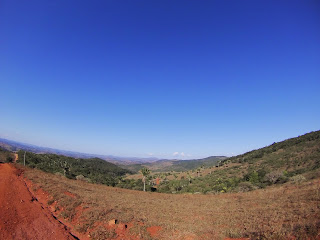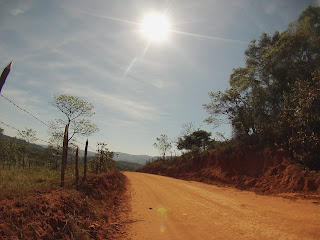I felt very weak leaving the city. The stomach was ill until
11 and there was nothing in my body but I knew I could not eat solid food. I
drank a liter of yoghurt—I was starving, perhaps something liquid might work. I
considered staying another night, but I wanted to get to Diamantina .
I headed to the park to get in a workout, and while the arms felt fine, the
legs were weak.
The sun was intense, as always, and I knew from the profile
of the route from the internet that the day would be very hard. I turned on to
orange dirt road and powered up a steep climb. Immediately I saw the valley and
the palms and the exposed rock of the mountains surrounding. But the sun was
getting to me already. I got stuck in what I thought was a small section of
sand and pushed the bike patiently. Yet the sand didn’t end. I continued to
push for 1km and felt dread.
Intermittently I was able to ride, but ever 200 meters or so
the deep white sand or deep silty orange silt would emerge and the tires would
sink into the earth and the bicycle would come to a halt and I would have to
push from the left or to the right, or, sometimes, straddling the bike.
It went this way for 4km, and I extrapolated that if it
continued at this rate, it would take 10 hours or more to ride the 36km to
Morro do Pilar. I felt very weak and was about to head back to the city and
sheepishly stay another night. I saw a farm house and walked to the gate. I
called ahead and asked if I could enter. A man came out and sat down. He was
probably my age but he had a bit more heft. I lifted the chain on the gate and
arrived in the shade of the porch.
“Look, I’m riding to Morro do Pilar today and it’s about
36km, but I didn’t expect this sand. I can’t ride in this sand. Is the whole
route like this? If so, I think I’ll have to return and find another way to Diamantina .”
“No, no, you only have 3-4km of this type of sand and then
the road improves. They came by with a machine and it created the silt and
sand.”
“Ah, it needs to rain, then the road will harden.”
“Exactly.”
His wife came out chimed in.
“It gets much, much better. Only 4km more of this sand. A
machine came by.”
I thought of 4km of walking the bike in the sand and the
sun. The bike was heavily loaded and it was difficult and slow to push the
bicycle.
“Like, the entire way is like this, with the sand?”
My question was slightly pathetic, as it wasn’t their fault.
This was the land, this was how the land fell on the earth. If I wanted
highway, I could have taken highway. I could have flown. Why the hell did I
have to stop and discuss the route? Why didn’t I just ride on or push on and just
take a chance?
“No, no, you have patches for a few hundred meters, then it
gets better. But after, 3, 3 or 4km, the roads gets solid again. Then only a
few times do you get anymore sand. Hey, have you eaten lunch.”
I thanked the couple for the offer of lunch but I had to
refuse as I couldn’t handle the solid food. I got back on the road and began to
push my bike. I car pulled up beside me, and it was a familar face—Sideni, the
guy from the bar the night before who had introduced me to everyone, the bartenders,
his friends, anyone who passed by. He lived in Morro do Pilar with his wife and
daughter but was in Itambé do Mato Dentro for the night. Sideni drew me a map
showing the route to Morro do Pilar. There was a turnoff on the left for a
fazenda but I wasn’t to make the turn—it would result in a hilly deadend round
trip of 8km. There was a sign for the home of a man who played a wicked folk
guitar. He lived for 80 years and died not three years ago. “Just see the sign
when you pass it and know that he lived there. He was a great guitarist. The
man came to town and never asked for anything, just an almoço.”
And
here he was, just as I needed the moral support.
“Remember
that I drew on the map where the bad sand was. Just push your bike. Don’t try
to ride. It will only frustrate you. Soon the road gets better. Do you want a
ride?”
I
told Sideni I would walk, ride, or die, but not accept a ride. He said he was
on his way to Morro do Pilar and would see me when I arrived.
I
continued to push in the sand, but I now knew with certainty that the sand
would end and the road would get better.
I
man on horseback passed me as I weaved back and forth, pushing my bike in the
sand.
“It
gets much better in 3km,” I told him. “You will see stretches of sand, but then
it will get better. We just need some rain.” The man looked at me quizzically
and let out an “Opa” and rode on. As he rode off into the distance, I heard
some rustling alongside the barbed-wire fence. A horse came to my side and
stopped and, if I looked closely enough, could tell he was smiling. I gave a
big smile back and gave an “Opa” to the horse and told him to go with God.
The
sand ended and I reached the top of one of many summits. There was white sand,
white rock outcroppings, tan boulders, palm trees, orange earth, verdant
bushes. I past the sign near the home of the guitarist.
The
climbing continued in the sun and there several more patches of thick sand
through which I had to push the bike once again. Mining trucks passed and
kicked up much dirt. A large pipeline project was evident from the roadside.
---------------------
I
had ridden 27km from Morro do Pilar and had arrived in Concecão do Mato Dentro
in 4 hours. Some of the climbing was shaded but the grade was very steep and I
would lose traction from a stone or from patches of loose silt. I passed by an
eatery and two men sitting under an umbrella told me the almoço was good and
cheap, a prato feito, but as many as I wanted. I dug into my food and sat with
the two guys. Vailton’s friend pointed to my rear saddle bag. “What’s the stuff dripping from your bag?” I opened up the saddle bag and pulled out an empty,
broken wine bottle. Viko had given me a bottle of his wine and I wanted to
bring it back to São Paulo but the neck had broken most likely going over some
of the larger rocks. The cold weather gear was saturated in wine. I went to a
hose and washed off the clothes and filled the water bottles. I sat back down
with Vailton and his friend and they told me of their horseback rides on the
Estrada Real. “On a moto or on your bike you can’t let down your guard. You
can’t have a cachazinha, you can’t drink a beer, you can’t smoke. But on a
horse, you can do all these things, and he takes you 40km a day."
He
had been riding from Diamtina and was on his way to Ouro Preto. I told him I
was trying to get to Diamantina in 4 days and he said it would be a stretch—the
climbing just get worse the closer you get to Diamantina. Normally I dismiss
all remarks about difficulty, but here was a guy riding the same trail. I told
him I knew, I knew it would get worse. The topographic profile looked very
sinister. I remembered how Francisco, the 18-year old cyclist I had ridden
with in Colorado, remarked that the mountains of Colorado are easy compared to
the Ozarks. The Estrada Real must be the Ozarks of Brasil. I had ridden the
bicycle a bit before riding the Estrada Real. I had ridden the bicycle in
different climates and conditions. But the Estrada Real is difficult in a pure
way: the roads are viciously steep and unpredictable. You ride them because the
beauty is melodic. Melancholy and beauty
are often inseparable.
I
gave the cyclist my email and my blog address and was ready to keep chasing the
light, when a man came from the car with a huge studio camera and began filming
out conversation. The cyclist was a television personality from Rio working for
national television and they were filming his journey for a television show.
They began to film me and interview me about my journey. I spoke quickly
because I was running out of light, but I illustrated on my map where I had
ridden, and spoke highly of the Estrada Real. They were also perhaps taken
aback a bit by the hyper gringo covered in orange dirt giving them a lecture in
Brazilian history.
I made it to Corregos as the sun set. 240 people live in the town. I ate on the street, very exhausted, and 2 old men and two old women kept me company. The ice cream shop made me dinner and it was strange to eats beans and rice as the kids came and went for ice cream.


















































